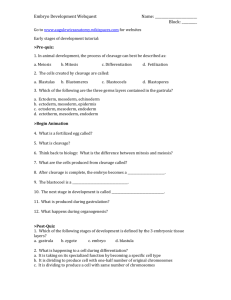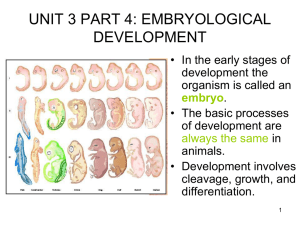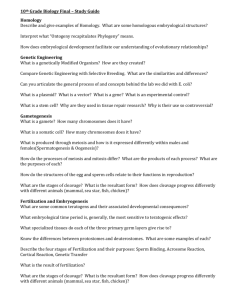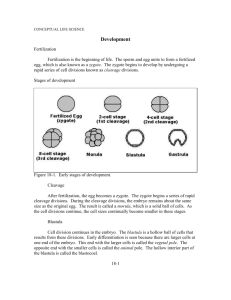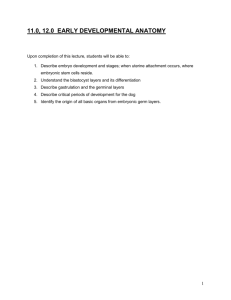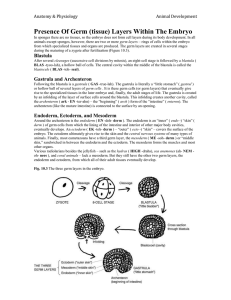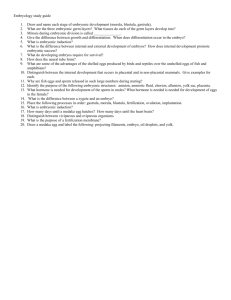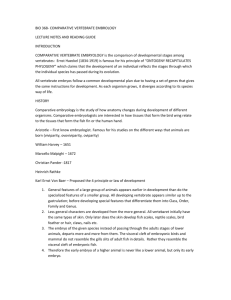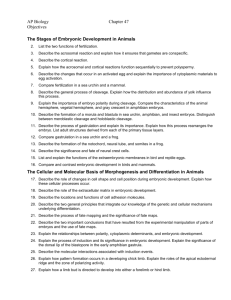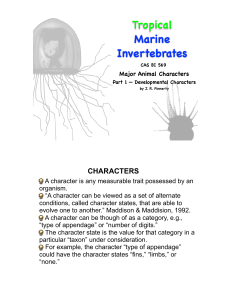OVERVIEW: Plants are defined as multicelled
advertisement
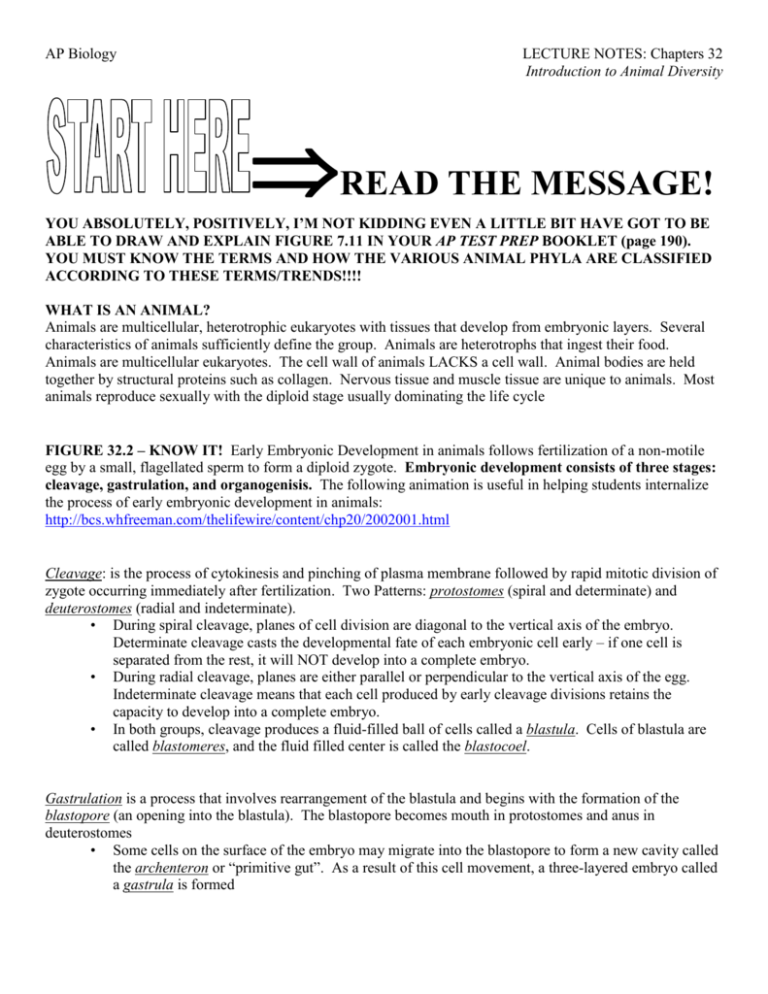
AP Biology LECTURE NOTES: Chapters 32 Introduction to Animal Diversity READ THE MESSAGE! YOU ABSOLUTELY, POSITIVELY, I’M NOT KIDDING EVEN A LITTLE BIT HAVE GOT TO BE ABLE TO DRAW AND EXPLAIN FIGURE 7.11 IN YOUR AP TEST PREP BOOKLET (page 190). YOU MUST KNOW THE TERMS AND HOW THE VARIOUS ANIMAL PHYLA ARE CLASSIFIED ACCORDING TO THESE TERMS/TRENDS!!!! WHAT IS AN ANIMAL? Animals are multicellular, heterotrophic eukaryotes with tissues that develop from embryonic layers. Several characteristics of animals sufficiently define the group. Animals are heterotrophs that ingest their food. Animals are multicellular eukaryotes. The cell wall of animals LACKS a cell wall. Animal bodies are held together by structural proteins such as collagen. Nervous tissue and muscle tissue are unique to animals. Most animals reproduce sexually with the diploid stage usually dominating the life cycle FIGURE 32.2 – KNOW IT! Early Embryonic Development in animals follows fertilization of a non-motile egg by a small, flagellated sperm to form a diploid zygote. Embryonic development consists of three stages: cleavage, gastrulation, and organogenisis. The following animation is useful in helping students internalize the process of early embryonic development in animals: http://bcs.whfreeman.com/thelifewire/content/chp20/2002001.html Cleavage: is the process of cytokinesis and pinching of plasma membrane followed by rapid mitotic division of zygote occurring immediately after fertilization. Two Patterns: protostomes (spiral and determinate) and deuterostomes (radial and indeterminate). • During spiral cleavage, planes of cell division are diagonal to the vertical axis of the embryo. Determinate cleavage casts the developmental fate of each embryonic cell early – if one cell is separated from the rest, it will NOT develop into a complete embryo. • During radial cleavage, planes are either parallel or perpendicular to the vertical axis of the egg. Indeterminate cleavage means that each cell produced by early cleavage divisions retains the capacity to develop into a complete embryo. • In both groups, cleavage produces a fluid-filled ball of cells called a blastula. Cells of blastula are called blastomeres, and the fluid filled center is called the blastocoel. Gastrulation is a process that involves rearrangement of the blastula and begins with the formation of the blastopore (an opening into the blastula). The blastopore becomes mouth in protostomes and anus in deuterostomes • Some cells on the surface of the embryo may migrate into the blastopore to form a new cavity called the archenteron or “primitive gut”. As a result of this cell movement, a three-layered embryo called a gastrula is formed AP Biology LECTURE NOTES: Chapters 32 Introduction to Animal Diversity In most animals, the gastrula consists of three differentiated layers called the embryonic germ layers, each of which develops into all parts of the adult animal: • Endoderm – forms viscera including lungs, liver, and digestive organs • Ectoderm – becomes skin and nervous system • Mesoderm – gives rise to muscles, blood, and bones Organogenesis is the process by which cells continue to differentiate, producing organs from the three embryonic germ layers. Once all organ systems have been developed, the embryo simply increases in size. Hox Genes and Animal Morphology/Body Plans All animals and only animals have Hox genes that regulate the development of body form. Hox genes are special regulatory genes that control the transformation of a zygote to an animal of specific form. Explosion of Animal Diversity Paleozoic Era (542–251 Million Years Ago) • The Cambrian explosion marks the earliest fossil appearance of many major groups of living animals Mesozoic Era (251–65.5 Million Years Ago) • During the Mesozoic era dinosaurs were the dominant terrestrial vertebrates and coral reefs emerged, becoming important marine ecological niches for other organisms Cenozoic Era (65.5 Million Years Ago to the Present) • The beginning of this era followed mass extinctions of both terrestrial and marine animals • Modern mammal orders and insects diversified during the Cenozoic AP Biology LECTURE NOTES: Chapters 32 Introduction to Animal Diversity FIGURE 32.7 – KNOW IT! Body Symmetry in Animals Animals can be categorized according to the symmetry of their bodies, or lack of it (radial or bilateral). Bilaterally symmetrical animals have • A dorsal (top) side and a ventral (bottom) side • A right and left side • Anterior (head) and posterior (tail) ends • Bilateral symmetry is adaptive in that it facilitates forward movement in animals (dorsal/ventral and anterior/posterior) motion. • Cephalization, the development of a head – an evolutionary trend toward the concentration of sensory equipment on the anterior end (toward the head) – adaptive in that it facilitates sophisticated response to stimuli – result of bilateral symmetry Tissues in Animals Animal body plans also vary according to the organization of the animal’s tissues • Tissues are collections of specialized cells isolated from other tissues by membranous layers. Animal embryos form germ layers, embryonic tissues, including ectoderm, endoderm, and mesoderm – these germ layers are adaptive in that they facilitate specialization of cells for particular functions in the body. – Ectoderm covers the surface of the embryo and gives rise to the outer covering of the animal – Endoderm is the innermost germ layer which lines the digestive tract and organs – Mesoderm lies between the endoderm and the ectoderm – it forms muscles and most other organs between the digestive tube and outer covering of the animal • Diploblastic animals have two germ layers whereas Triploblastic animals have three germ layers. AP Biology LECTURE NOTES: Chapters 32 Introduction to Animal Diversity FIGURE 32.9 – KNOW IT! Protostome and Deuterostome Development Based on certain features seen in early development many animals can be categorized as having one of two developmental modes: protostome development or deuterostome development: • In protostome development, cleavage is spiral and determinate. The splitting of the initially solid masses of mesoderm to form the coelomic cavity is called schizocoelous development. The blastopore becomes the mouth. • In deuterostome development, cleavage is radial and indeterminate. Formation of the body cavity is described as enterocoelous development. The blastopore becomes the anus. AP Biology LECTURE NOTES: Chapters 32 Introduction to Animal Diversity FIGURE 32.8 – KNOW IT! Body Cavities in Animals In triploblastic animals a body cavity may be present or absent. A body cavity is a “tube-within-a-tube” body plan consisting of a fluid-filled space separating the digestive tract from the outer body wall. Examples of each type are as follows: (1) coelomates annelids; (2) pseudocoelomates (nematodes); (3) acoelomates (flatworms). Review of Early Embryonic Development in Animals – CAN YOU DRAW AND DESCRIBE THIS? http://bcs.whfreeman.com/thelifewire/content/chp20/2002001.html
